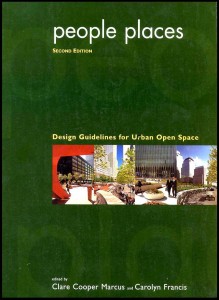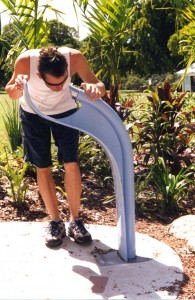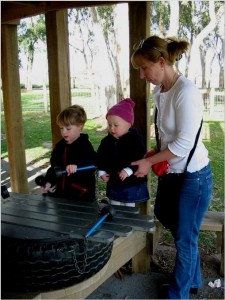
24 March 2011
Healthy spaces and places are now everywhere!
It’s wonderful to see the worlds of planning and urban design catching up with the fields of landscape architecture and environmental psychology! And catching up worldwide!
For years –under the tutelage of Professor Emerita Clare Cooper Marcus of Berkeley, I have been studying and writing about the healing power of place. Now it’s very much part of the planning discourse. We know that designing parks, public spaces and even streets with human use, comfort and enjoyment in mind can increase their use — and the health of those who use them.
What is less well known in planning is the powerful effects of the natural world on human physical and mental well-being.
These effects have been documented by decades of empirical research which reveal that as simple an addition as a photograph of a natural scene in a hospital room can greatly increase your chances (and speed) of recovery from surgery. That’s why dentists have photographs of trees and gardens on their surgery ceilings!
Placemaking is making a comeback
My early work in this field began back in 1978, when I taught Clare’s popular course at Berkeley: Landscape Architecture 140: Social Factors in Public Open Space. My students studied parks and plazas, dangerous San Francisco public housing estates, Berkeley playgrounds, even city streets — all with one intention: to examine the fit or congruence between the users and those environments.
Together we wrote Housing as if People Mattered: Illustrated Site-Design Guidelines for Medium-Density Family Housing (University of California, 1986), with three chapters on open space.
Urban design guidelines grew from that and other initial research, ultimately compiled into Clare’s award-winning manual (with Carolyn Francis): People Places: Design Guidelines for Urban Open Space (now in its second edition). See: https://www.amazon.com/People-Places-Design-Guidlines-Urban/dp/0471288330
International initiatives
While it’s great to see a new emphasis on placemaking and healthy environments, it’s also important to remember that there has been a great deal of research in this field — for decades. As planners rediscover placemaking, let’s not forget the basics.
And placemaking and place management are not the same as community development, however fashionable it might be to think so.
The basics of placemaking are — and will remain — the same: the fit between places and those who use them. When we add the dimension of intergenerational equity — then we want that fit to continue — for at least seven generations!
It’s been encouraging to see work on planning and health emerging from all the English-speaking countries I have contact with.
The number and kinds of initiatives currently being pursued internationally and in Australia are very encouraging and demonstrate the widespread recognition of the importance of bringing health and planning practitioners together to address issues of mutual interest.
For example, in the UK, see: the award-winning work in London of the Healthy Urban Development Unit (HUDU): Planning for Health in London: The ultimate manual for primary care trusts and boroughs (2009), and the Health and Urban Planning Toolkit (2007) a comprehensive guide for planners and health practitioners.
The Toolkit, winner of the 2007 RTPI Planning Process Award, is available at: www.healthyurbandevelopment.nhs.uk
In Canada, Bringing Health to the Planning Table (2009), available from PHAC at: https://www.phac-aspc.gc.ca/publicat/2009/be-eb/
The British Columbia version, “Planning 101“, is at www.phsa.ca/PopulationHealth.
In the United States, the American Planning Association (APA) has been very active in the field. See: the APA’s Comprehensive Planning for Public Health: Results of the Planning and Community Health Research Center Survey (March 2011) available at: www.planning.org/research/publichealth/index.htm.
Integrating Planning and Public Health: Tools and Strategies to Create Healthy Places (2006); and Public Health Terms for Planners and Planning Terms for Public Health Professional are resources also produced by the APA.
And in New Zealand, Healthy Places, Healthy Lives is a guiding document for the integration of the health and planning professions in New Zealand. It can be found at: https://nhc.health.govt.nz/publications/phac-pre-2011/healthy-places-healthy-lives-urban-environments-and-wellbeing
Parks and healing
Recently I had the pleasure of compiling a report on the healing effects of parks and pubic spaces for older people and people with dementia for an expert witness consultancy for a large suburban council in Queensland. Reviewing several hundred documents, I was delighted to see how quantitative and qualitative research approaches have now combined to put flesh on the bones of some basic theories and studies conducted several decades ago.
Now it’s been documented without a shadow of a doubt that Nature can heal us!
As if we didn’t know that already!
But this wide body of empirical research, carefully analysed by Australian researchers, can give us hope: even in the most depressing places, a view from a deck or porch, a small local park, a glimpse of a view in a public space, a bench situated in a shady spot — can support the well-being of local people.
Thus, the discourse about health and Nature extends well beyond supportive environments for physical activity or obesity control. It delves deeply into our hearts and minds: our mental and psychological well-being. Parks are much more than the “lungs of the Earth”. They’re a way to comfort us, a place people can take their problems; they are restorative down to the cellular level. Parks are a local (and often small and urban) manifestation of the healing power of the Earth.
And that’s why great care in the micro-design features of park design is so essential: to support all the ways that people need to be in Nature: solitary, grieving, joyful, with others, active, passive, with children… All ways!
A recent literature review is available at:
Healthy parks, healthy people: The health benefits of contact with nature in a park context, a review of relevant literature, 2nd edition, March 2008 by Cecily Maller, Mardie Townsend, Lawrence St Leger, Claire Henderson-Wilson, Anita Pryor, Lauren Prosser, and Megan Moore.
See:
https://parkweb.vic.gov.au/__data/assets/pdf_file/0018/313821/HPHP-deakin-literature-review.pdf
I’ll review some of the relevant issues in that literature in future blog posts.
It’s particularly relevant with regard to climate change, as including Nature in cities could have additional environmental benefits, such as habitat provision and improved environmental performance of built environments.
There’s a great deal of material to guide planners and designers.
For Australian guidance, see: https://www.healthyplaces.org.au/site
Resources on the restorative power of Nature
For some of my keynote addresses and lectures on the restorative powers of Nature, just click on the links below:
Children, play and public open space
- Are we shutting kids out review of child-friendly cities engagement 2004
- Best practice in Parks Forum 2002
- Community engagement for children Gallilee School 2009
- Growing Up Why Nature is essential in residential areas UTS 2009
- Housing as if Little Guys Mattered Arguments for Shared Space in Housing 2003
- Social factors in the design of urban parks Adelaide University 2010
- The Child in the Wild Galilee School Symposium 2009
- The restorative power of parks and public spaces what works and doesn’t work 2010
- Urban Nature for Everyone The Value of Natural Places in Cities Asia Pacific Cities Summit 2007
- Why Planners Hate Nature 2005
- Stories in a Park Eagleby 2006
Housing, liveability and density
- Density and liveability at False Creek North UDIA Perth 2009
- False Creek South from a distance 2007
- The Social Stigma of High-Rise Development for Property Council of WA 2005
- Thinking about a new suburban community UTS 2009
If you are seeking more, please email me: [email protected]

